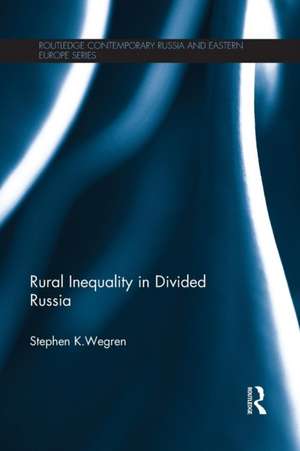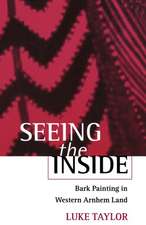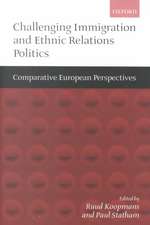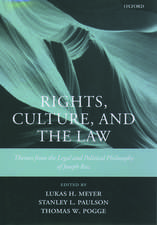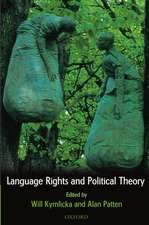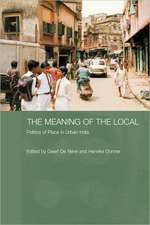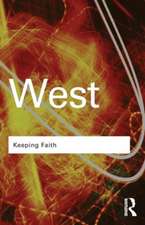Rural Inequality in Divided Russia: Routledge Contemporary Russia and Eastern Europe Series
Autor Stephen Wegrenen Limba Engleză Paperback – 9 dec 2015
| Toate formatele și edițiile | Preț | Express |
|---|---|---|
| Paperback (1) | 389.38 lei 6-8 săpt. | |
| Taylor & Francis – 9 dec 2015 | 389.38 lei 6-8 săpt. | |
| Hardback (1) | 1171.89 lei 6-8 săpt. | |
| Taylor & Francis – 23 iul 2013 | 1171.89 lei 6-8 săpt. |
Din seria Routledge Contemporary Russia and Eastern Europe Series
-
 Preț: 309.79 lei
Preț: 309.79 lei -
 Preț: 326.49 lei
Preț: 326.49 lei -
 Preț: 326.15 lei
Preț: 326.15 lei - 9%
 Preț: 1010.71 lei
Preț: 1010.71 lei -
 Preț: 321.03 lei
Preț: 321.03 lei -
 Preț: 302.33 lei
Preț: 302.33 lei -
 Preț: 325.21 lei
Preț: 325.21 lei - 9%
 Preț: 934.70 lei
Preț: 934.70 lei -
 Preț: 318.10 lei
Preț: 318.10 lei -
 Preț: 379.30 lei
Preț: 379.30 lei - 18%
 Preț: 1111.51 lei
Preț: 1111.51 lei - 18%
 Preț: 1058.79 lei
Preț: 1058.79 lei - 25%
 Preț: 824.70 lei
Preț: 824.70 lei -
 Preț: 464.54 lei
Preț: 464.54 lei - 18%
 Preț: 950.71 lei
Preț: 950.71 lei - 18%
 Preț: 1168.76 lei
Preț: 1168.76 lei - 24%
 Preț: 130.54 lei
Preț: 130.54 lei - 26%
 Preț: 821.46 lei
Preț: 821.46 lei - 18%
 Preț: 1169.78 lei
Preț: 1169.78 lei -
 Preț: 413.98 lei
Preț: 413.98 lei -
 Preț: 387.49 lei
Preț: 387.49 lei -
 Preț: 406.52 lei
Preț: 406.52 lei - 18%
 Preț: 1059.93 lei
Preț: 1059.93 lei - 18%
 Preț: 1218.26 lei
Preț: 1218.26 lei -
 Preț: 418.13 lei
Preț: 418.13 lei - 18%
 Preț: 1171.89 lei
Preț: 1171.89 lei - 18%
 Preț: 1057.57 lei
Preț: 1057.57 lei -
 Preț: 413.37 lei
Preț: 413.37 lei - 18%
 Preț: 707.96 lei
Preț: 707.96 lei - 18%
 Preț: 1058.65 lei
Preț: 1058.65 lei - 18%
 Preț: 948.84 lei
Preț: 948.84 lei - 18%
 Preț: 706.91 lei
Preț: 706.91 lei - 18%
 Preț: 1059.84 lei
Preț: 1059.84 lei -
 Preț: 488.33 lei
Preț: 488.33 lei - 18%
 Preț: 1056.28 lei
Preț: 1056.28 lei -
 Preț: 390.12 lei
Preț: 390.12 lei - 18%
 Preț: 1053.16 lei
Preț: 1053.16 lei - 18%
 Preț: 1056.28 lei
Preț: 1056.28 lei - 28%
 Preț: 850.91 lei
Preț: 850.91 lei - 18%
 Preț: 1050.78 lei
Preț: 1050.78 lei - 18%
 Preț: 1166.68 lei
Preț: 1166.68 lei - 18%
 Preț: 1058.79 lei
Preț: 1058.79 lei - 18%
 Preț: 1958.23 lei
Preț: 1958.23 lei - 18%
 Preț: 1221.74 lei
Preț: 1221.74 lei
Preț: 389.38 lei
Nou
Puncte Express: 584
Preț estimativ în valută:
74.51€ • 79.67$ • 62.12£
74.51€ • 79.67$ • 62.12£
Carte tipărită la comandă
Livrare economică 17 aprilie-01 mai
Preluare comenzi: 021 569.72.76
Specificații
ISBN-13: 9781138643437
ISBN-10: 1138643432
Pagini: 314
Ilustrații: 8
Dimensiuni: 156 x 234 x 15 mm
Greutate: 0.45 kg
Ediția:1
Editura: Taylor & Francis
Colecția Routledge
Seria Routledge Contemporary Russia and Eastern Europe Series
Locul publicării:Oxford, United Kingdom
ISBN-10: 1138643432
Pagini: 314
Ilustrații: 8
Dimensiuni: 156 x 234 x 15 mm
Greutate: 0.45 kg
Ediția:1
Editura: Taylor & Francis
Colecția Routledge
Seria Routledge Contemporary Russia and Eastern Europe Series
Locul publicării:Oxford, United Kingdom
Public țintă
PostgraduateCuprins
Part 1: Context 1. Rural Inequality in the Soviet Period 2. Inequality in Post-Soviet Russia 3. Rural Inequality and Agrarian Capitalism in Post-Soviet Russia 4. Rural Poverty in Post-Soviet Russia Part 2: Factors Affecting Rural Inequality 5. Rural Inequality and Human and Social Capital 6. Rural Inequality and Profession 7. Rural Inequality and Gender 8. Rural Inequality and Location Part 3: Consequences 9. Rural Inequality and Russia’s Future
Recenzii
'Using materials accumulated in large-scale surveys conducted in the 2000s, as well as an impressive array of Russian- and English-language secondary sources, the author charts the scope, contours, and causes of rural inequality after the Soviet Union. Individual chapters explore dimensions of inequality, ranging from social capital to profession and from gender to location, combining to provide a multifaceted picture of the Russian countryside in recent years. Wegren's overall approach is institutional, and he locates the driving factors of inequality creation in the design of post-Soviet institutions impacting rural life. Although rural inequality in Russia is at its highest level since the Russian Revolution of 1917, Wegren concludes that it is unlikely to be a source of social instability in Russia in the foreseeable future. Summing Up: Recommended.' – D. Rogers, Yale University, CHOICE Magazine, July 2014 Vol. 51 No. 11
Descriere
This book examines economic and political polarisation in post-Soviet Russia, and in particular analyses the development of rural inequality. It discusses how rural inequality has developed in post-Soviet Russia, and how it differs from the Soviet period, and goes on to look at the factors that affect rural stratification and inequality, using human and social capital, profession, gender, and village location as independent variables. The book uses survey data from rural households and fieldwork in Russia in order to highlight the multiplicity of divisions that act as fault lines in contemporary rural Russia.
